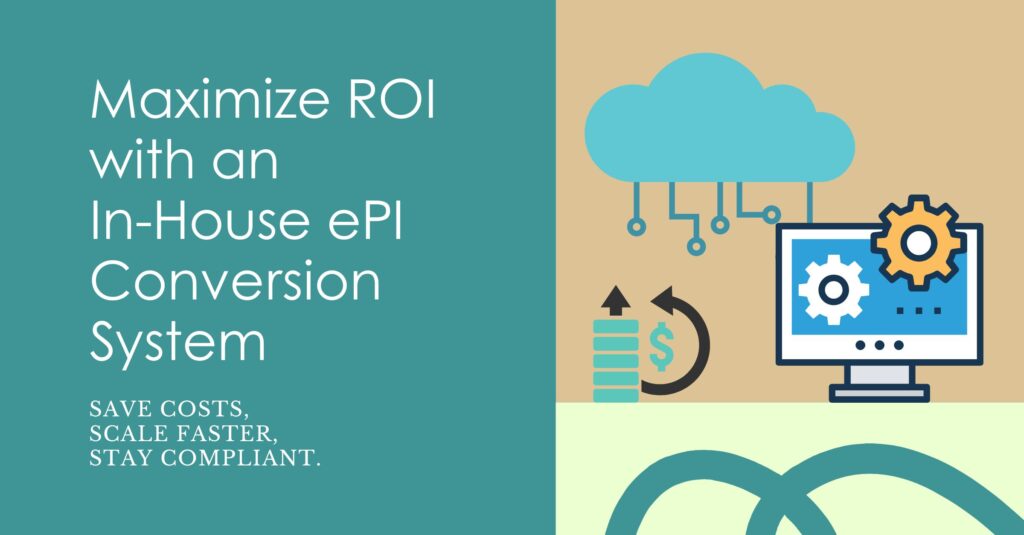
Electronic Product Information (ePI) with FHIR standards is a fast-growing regulatory requirement, prompting pharmaceutical companies to evaluate how best to manage this transition. Companies are facing increasing operational and financial decisions to remain compliant and need to determine if they will leverage an outsource vendor, implement a solution in house, or both. For many, implementing a solution in-house presents an opportunity for significant cost savings and enhanced efficiency.
Below, we break down the core components of ROI for companies moving toward an internal solution.
1. Cost Savings on High-Volume Conversions
An individual ePI conversion costing hundreds of dollars when outsourced. High-volume demands quickly lead to exponential costs. As more countries adopt FHIR-based ePI mandates, organizations are looking at a significant cost to sustain compliance. Add in frequent updates or new product rollouts, and this cost burden quickly becomes substantial.
An in-house ePI solution eliminates costs by reducing reliance on third-party services. After the initial setup and training, each conversion completed internally represents savings that directly impact the bottom line. Over a three- to five-year period, these savings often offset initial implementation expenses, especially as more countries are requiring ePI FHIR compliance.
Additionally, companies using an in-house system can plan and budget more predictably without unexpected costs. By owning the process, companies gain flexibility and transparency into the overall conversion workflow, avoiding per-conversion charges that can vary based on vendor pricing or service complexity.
2. Scalability and Adaptability for Future Growth
A key ROI advantage of an in-house system is its scalability. Unlike outsourced conversions, which charge per label, an internal solution allows a company to process an unlimited number of labels for countries, products, or regulatory changes without additional costs. As ePI adoption spreads, companies will have a flexible and predictable framework for handling conversions.
The ability to adapt quickly is also crucial for staying compliant. With an in-house system, companies can address regulatory updates or label revisions promptly, minimizing operational disruptions. This quick adaptability is especially important when multiple labels or product lines require simultaneous updates, which could otherwise incur delays or additional fees if outsourced.
3. Time Savings and Faster Market Access
When it comes to managing a large portfolio of products or bringing a new drug to market, speed is essential. Each label conversion must meet specific regulatory requirements, and even minor delays can hold back the timeline for launching products or updating information. For companies with a substantial volume of labels, relying on outsourced conversions can quickly become unsustainable. This can result in extended timelines that aren’t manageable at scale.
An in-house ePI conversion system provides on-demand, real-time conversions, allowing teams to generate labels and make necessary updates immediately. This control over the conversion process supports rapid market access, especially critical when responding to frequent regulatory changes across regions. For large companies, this speed-to-market advantage is not just a time-saver but a competitive edge, ensuring they remain agile, compliant, and profitable in an evolving regulatory landscape.
4. Long-Term ROI with Reduced Per-Conversion Costs
The ROI of implementing an in-house ePI conversion system compounds over time. After the initial investment, each conversion contributes to long-term savings, as companies no longer pay the per-label fees associated with outsourcing. This reduced per-conversion cost is especially significant for companies managing multiple brands, products, and regions, where the frequency of label changes is high.
For example, companies that convert thousands of labels per year each save hundreds of thousands annually by bringing the process in-house, which offsets the system’s initial cost within the first few years. By Year 5, these savings can represent a substantial ROI, especially when considering scalability benefits and reduced operational delays.
Beyond these immediate savings, in-house systems often have a longer lifespan, allowing companies to spread their investment over many years. This approach supports a predictable and sustainable growth model, helping companies allocate resources toward other areas, like product innovation or market expansion.
Is an In-House System Right for You? Key Considerations
While the ROI is compelling, here are some considerations to evaluate before implementing an in-house ePI conversion system:
- Volume of Conversions: Companies with high conversion volumes benefit most, as the cumulative savings from avoiding per-conversion fees increase with each label processed.
- Internal Resources: Consider the availability of staff and IT infrastructure to support the system and manage ongoing updates.
- Future Projections: Assess whether ePI FHIR adoption is expected to rise in your operating regions. Companies anticipating expanded regulatory requirements stand to gain the most from in-house flexibility.
Conclusion
Investing in an in-house ePI conversion system is a proactive step that helps pharmaceutical companies stay agile, reduce costs, and streamline regulatory compliance as demand grows. As more countries adopt ePI standards, the companies prepared with scalable, in-house solutions will find themselves positioned for operational and financial success, yielding a solid return on investment over time.
Implementing an ePI conversion system may require an upfront commitment, but the benefits—cost savings, faster compliance, and adaptability—make it a strategic move for pharma companies looking to future-proof their regulatory processes.
Ready to upgrade your ePI conversion workflow? Contact Glemser today to get started.


